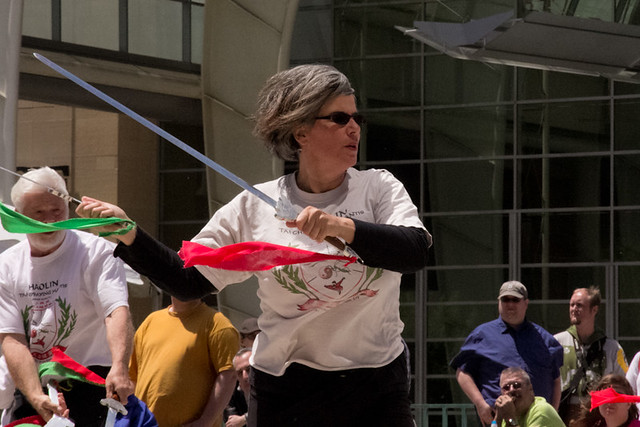 |
| "Scott Rodell cutting jian" Licensed via Wikimedia Commons. |
It will take a student at least 10 years of Tai Chi experience to handle the real thing. Point is, the teachers take their craft very seriously. That is why some hesitate to teach the sword unless they are sure that the person can handle the blade in its essence. It is seldom to encounter a master that teaches the sword because it is a very dangerous thing to learn especially if the person in not really equipped to learn it. Some will not teach it at all.
That was before. In this generation, there are a lot of teachers that allow the students to learn the way of the sword, instantly, after knowing the basic of Tai Chi. As a sort of progression first, they would teach the students the basic things like standing meditation. Push Hands will come next. There would also be some specific moves like the Tchoung style in its fast form. Practicing these conveys a solid foundation of the techniques and movements of the body.
Weapons will be introduced. They have varieties of teachings regarding swords like tao, chien, etc. After mastering the independent use of the swords, they would continue to practice but this time, in twos. Practitioners will arrange the sword patterns then comes the moment of sparring.
When chien is used in sparring, it is like practicing Push Hands with a weapon. Similar circular movements are the ones that are used to nick, thrust, slice and cut. Chopping movements can be found in tao but not in chien applications.
Concepts
Every type of martial art revolves around concepts. An art’s methods of training must always reflect the concepts and must see to it that every movement is in harmony with the entire faculty. In Tai Chi sword, there are specifications, that wouldn’t be a surprise. Sadly, the stiff and wooden way that is taught by some instructors doesn’t reflect the energy predicted in Tai Chi.
Tai Chi Chuan derives its concepts from several forms of performing the chien single-handedly. Yang style is the most common form. It is composed of 56 – 64 movements. The variations of the standard pattern will greatly depend on the school of thought and the emphasis of each one.
During the practice of the sword, a person must focus on the smoothness and calmness of the movement. The mind should be as calm as the quiet ocean to be able to reflect the innermost feeling of a person. The body must stay afloat like sailing into clear skies.
One of the reasons why people study the art of the sword is because the weapon brings the elements of the mind and the body in unity. To use the sword correctly, one must assume that is it a part of his body and not just a weapon of destruction.
He must realize that the sword is a matter of importance that when taken away is a bigger ordeal.





